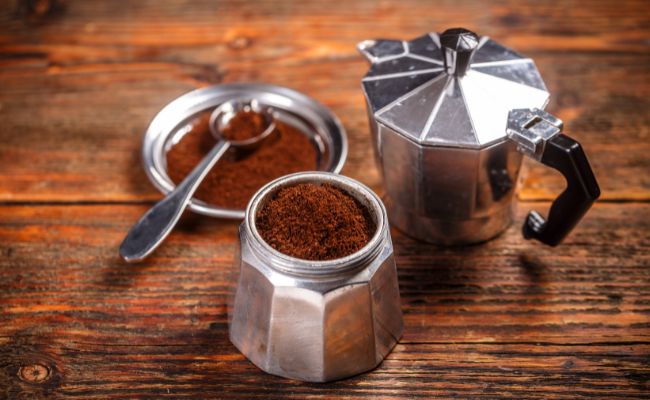Yeti French Press Analysis
Straight to the Degree
The Yeti French Press is heavy and durable. It brews an excellent cup of espresso with minimal silt and sediment, nevertheless it absolutely does dribble barely when poured.
Whereas touring via Japan, my husband and I completed at a specialty espresso retailer in Osaka. After sampling its espresso (one cup made in a French press and one different with a pour-over) we bought a couple of of the shop’s beans. The barista was joyful that we most well-liked the espresso ample to purchase it and requested what sort of espresso makers we had at residence. My husband and I checked out each other and laughed on account of our kitchen is overrun with brewers. We started itemizing our devices, and the barista nodded alongside wide-eyed.
At residence, if one amongst us is making a single cup of espresso, we do a pour-over. Nonetheless, if we’re every having espresso, entertaining mates, or just want a richer, full-bodied cup, we attain for a French press.
:max_bytes(150000):strip_icc()/yeti-rambler-34-oz-french-press-coffee-maker-a6b4fe818de745dfacd25f9febeffe37.jpg)
Though we already have seven French presses on our shelf (and a few additional in storage), I was excited to take a look at the newer one from Yeti. After testing it, I’m joyful to say it’s earned a eternal spot on our espresso shelf, subsequent to the Fellow Clara and ESPRO P7.
The Assessments
Essential Eats / Irvin Lin
- Heat Retention Verify: I preheated the French press with boiling water and brewed a batch of espresso using 60 grams of medium-coarse grounds and 930 grams of water, a 1:15.5 ratio (the producer’s suggestion). Using an instant-read thermometer, I well-known the espresso’s temperature immediately after brewing, and after 5 and 20 minutes. Following each temperature confirm, I moreover poured and drank the espresso to guage its prime quality. I then timed how prolonged it took for the espresso to drop all the way in which right down to 130°F, tasting it as quickly as as soon as extra.
- Fashion Verify 1: I brewed one batch of 1:16 ratio espresso (42.5 grams of espresso and 680 grams of water) using medium-coarse grounds. I stirred as quickly as on the one-minute mark and plunged after 4 minutes.
- Fashion Verify 2: I brewed one batch of 1:16 ratio espresso (42.5 grams of espresso to 680 grams of grams water), using very coarse espresso grounds, per Nick Cho’s recipe. I stirred as quickly as at 45 seconds and plunged after eight minutes.
- Usability and Cleaning Verify: Whereas making and sampling each batch of espresso, I took observe of how cozy the Yeti’s cope with was, how balanced the pot was, and if the lid dribbled. After ending the espresso, I took apart the French press, cleaned it utterly, and reassembled it.
What I Found
The Further Silicone Filter Cowl Was Superb
Essential Eats / Irvin Lin
What makes the Yeti utterly totally different from totally different French presses? The addition of a robust silicone flap that matches over the filter, which Yeti calls the “GroundsControl Filter.” It fits snuggly over the metallic mesh and makes pushing the filter down barely more durable. Nonetheless, the extra effort is worth it, as this flap serves two capabilities. First, it prevents silt and sediment from winding up inside the espresso. Second, this flap stops water from seeping once more into the grounds, which can lead to over-extraction.
Essential Eats / Irvin Lin
Inside the final step of this French press recipe, Nick Cho suggests pouring the espresso proper right into a separate vessel after plunging to forestall over-extraction. Nonetheless, this technique dirties two vessels, is overly fussy, and does away with any of the French press’s insulation that will protect espresso scorching. The Yeti’s silicone flap does the job fairly extra merely. After an hour, espresso from it was nonetheless scorching with none indicators of astringency, bitterness, or totally different proof of over-extraction.
The Ceramic Inside Was Good for Cleanup
Identical to the Fellow Clara (one amongst Essential Eats’ favorite French presses), the Yeti’s inside has a ceramic lining. That’s sturdy and stain-resistant, and the company has added it to a few its totally different merchandise, along with its stackable espresso cups and mugs.
I haven’t had the Yeti French press prolonged ample to appropriately check out the stain-resistant half, nevertheless the ceramic lining utterly made cleanup less complicated. Espresso grounds slid correct out and hand-washing the sleek inside went fast, with out having to clean off any espresso oil stains.
It Was Properly Designed Nevertheless Heavy
Essential Eats / Irvin Lin
Yeti states that this French press is “over-engineered,” that features 18/8 kitchen-grade stainless-steel, a double-walled vacuum physique, and a padded, non-slip bottom. All of these are good qualities, nevertheless they do add as a lot as a heavy French press. The 34-ounce press weighs two kilos, 12 ounces, whereas the 64-ounce mannequin is a pound heavier. In contrast, the Fellow Clara weighs merely over two kilos.
Its Plastic Lid Was Its Weakest Operate
Essential Eats / Irvin Lin
The Yeti French press has a lid constituted of thick, sturdy plastic and twists to lock on. The lid has a spot on prime, which is the place the espresso is poured from. (It’s not dissimilar to the ingesting piece on a journey mug.) This opening is about an inch from the sting.
This distance and the state of affairs of the opening means the espresso tends to dribble down the side of the French press after it’s poured. This facet of the design baffled me, as Yeti thought via a number of the totally different ache elements of French presses like sediment and cleanup nevertheless didn’t take pouring espresso into consideration as loads.
The Verdict
Essential Eats / Irvin Lin
The sturdy Yeti French Press has various flaws nevertheless makes good espresso. It’s supreme for folks who love the whole physique of French press nevertheless hate the sediment inside the last cup. It’s easy to clean, well-designed, and backed by a five-year assure, though the plastic lid does dribble a bit when pouring espresso.
The Professionals
This French press makes an essential cup of espresso with minimal silt. It’s easy to clean on account of its ceramic lining and can be dishwasher safe. The vacuum-sealed physique retains espresso scorching for not lower than three hours—a great deal of time to finish the pot. The French press itself is great sturdy and sturdy, with a non-slip base.
The Cons
The Yeti is heavier than totally different French presses, so of us with wrist or mobility factors would possibly want some difficulties using it. The lid’s opening dribbles, so consider that when pouring. Lastly, the 34-ounce Yeti costs $110. That’s $11 larger than the Fellow Clara French press and $70 costlier than the ESPRO P3, every of which have comparable capacities and are Essential Eats winners.
Key Specs
- Functionality: 34 or 64 ounces
- Dimensions: 8.25 x 6.125 x 4.25 inches (34-ounce); 10.25 x 7 x 5 inches (64-ounce)
- Provides: 18/8 stainless-steel with ceramic lining, silicone parts, and plastic lid
- Insulation: Certain, double-walled
- Filter kind: Single show with silicone “GroundsControl” filter over it
- Dishwasher-safe: Certain
FAQs
How do you utilize the Yeti French press?
The Yeti is rather like most French press espresso makers. Assemble the French press by attaching the robust silicone filter to the mesh filter and screwing it to the metallic rod. Boil water and let it stand for 30 seconds to sit back barely. Then add medium-coarse grounds to the pot and the acceptable ratio of water.
Typical ratios are 1:14 to 1:16, which means one half espresso grounds to 14 to 16 parts water. For two to three servings of espresso, this may occasionally indicate 42.5 grams of espresso to 680 grams of water for a 1:16 ratio. As quickly because the water is added, let it sit for one minute, stir various situations, after which let steep for an additional three minutes. Press the plunger down slowly and steadily, then pour.
How prolonged does the Yeti French press protect espresso scorching for?
All through testing, I found espresso solely dropped to 130°F after three hours. (That’s nonetheless scorching!) Espresso at this degree confirmed no indicators of over-extraction.
Why We’re the Specialists
- Irvin Lin is a former barista and coffee-obsessed drinker who owns over 25 brewers.
- He wrote the cookbook Marbled, Swirled, and Layeredwhich was picked by the New York Situations as among the many greatest baking cookbooks of 2016.
- He runs a weblog known as Eat the Love, the place he’s developed, photographed, and written recipes since 2010. Eat the Love was nominated twice for most interesting meals weblog by the Worldwide Affiliation of Culinary Professionals (IACP) in 2016 and 2022.
- He’s examined and reviewed tons of of kitchen objects, along with stand mixers and saucepans.





:max_bytes(150000):strip_icc()/baratza-virtuoso-conical-burr-coffee-grinder-56ad605134ce48b6bc064336062fac87.jpg?w=1200&resize=1200,0&ssl=1)
:max_bytes(150000):strip_icc()/Nespresso-Vertuo-Plus-Coffee-and-Espresso-Maker-by-DeLonghi-d7e75a052ae34fbe9d65c98dd65e7b16.jpg?w=1200&resize=1200,0&ssl=1)